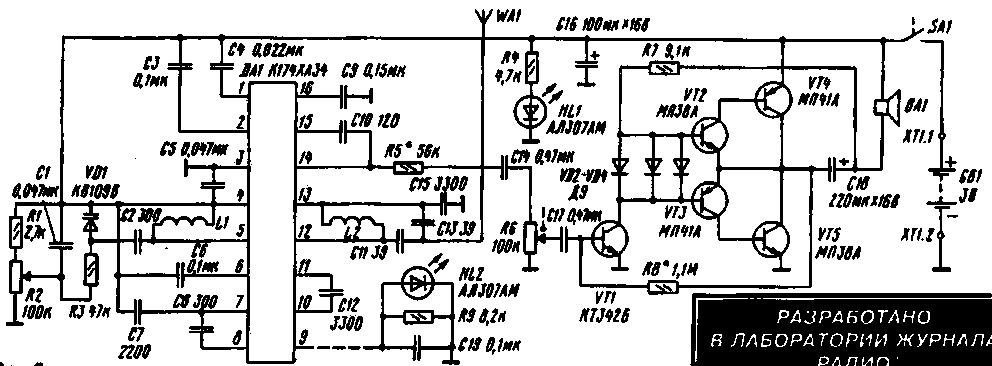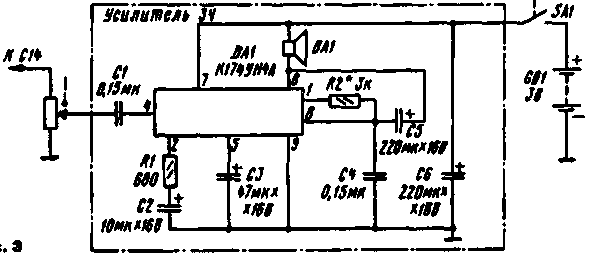
|
|
ENCYCLOPEDIA OF RADIO ELECTRONICS AND ELECTRICAL ENGINEERING UKB receiver - in a Marlboro pack. Encyclopedia of radio electronics and electrical engineering
Encyclopedia of radio electronics and electrical engineering / radio reception One of the undoubted advantages of the receiver is the ability to receive about a dozen popular radio stations in the range of 65,8 ... 74 MHz or 88 ... 108 MHz. In addition, the receiver has good parameters: its sensitivity is no worse than 7 μV, the output power is more than 40 mW, the signal-to-noise ratio is at least 40 dB, the current consumption in silent mode (in the absence of a received signal) is a maximum of 10 mA, and current consumption - no more than 35 mA. The sound emitter of the receiver (small dynamic head) reproduces signals in the frequency band 450.. .3150 Hz. The power source is a 3 V battery, the receiver remains operational when the voltage drops to 2 V. If two series-connected A316 elements are used as a power source, they will work continuously for 40...50 hours, and with "Varta" elements - 70...80 hours. The basis of the receiver (Fig. 1) is a multifunctional microcircuit K174XA34 (DA1), which is a ready-made superheterodyne VHF receiver, since it contains both a local oscillator, a mixer, an IF amplifier, a frequency detector, and a 3H preamplifier. In addition, there is an amplitude limiter and an automatic frequency control (AFC) system. It remains only to connect the hinged elements and "swing", if necessary, the 3-hour output signal to the required power - this was done in the radio laboratory of the Radio magazine, and with the maximum use of the typical inclusion of the microcircuit. From the WA1 antenna (it is a braided handle of the receiver made of a stranded mounting wire in insulation), the received signal is fed to the broadband input oscillatory circuit L2C11C13, designed for the selected range, and from the circuit to the input of the microcircuit (pins 12, 13). The L4C5VD1 local oscillator circuit is connected to another input of the microcircuit (pins 2. 1). By changing the resonant frequency of this circuit, the receiver is tuned to the desired radio station. The tuning organ in this case is the VD1 varicap. Its capacitance is changed electronically by applying one or another constant voltage to the varicap, taken from the engine of the variable resistor R2. In this case, the tuning frequency of the local oscillator exceeds the signal frequency of the received radio station by 75 kHz - the value of the intermediate frequency. All other signal processing - mixing, IF signal amplification, detection, pre-amplification of the 3H signal is carried out by the microcircuit. As a result, a 14-hour signal with an amplitude of at least 3 mV appears at pin 100, which, in principle, can be applied to a headphone with a resistance of at least 100 ohms. To obtain the highest 3H output signal, pin 16 of the microcircuit is connected to a common wire through capacitor C9. and to correct the pre-distortion of the FM signal and ensure greater stability of the amplifier, a capacitor C 15 is connected between terminals 14 and 10, which forms a negative feedback. At pin 9 of the microcircuit, a constant voltage is formed, inversely proportional to the level of the carrier frequency. It can be used for example. to indicate the tuning of the receiver to the radio station - the HL2 LED, which is also an indicator of the inclusion of the receiver, will go out when finely tuned to the radio station. True, in this version of the receiver, this circuit is not implemented. Coil L1 contains 12 turns on a frame with a diameter of 5 mm, winding length 12...16 mm. L2 contains 7 turns on the same frame, winding length 7...10 mm. Wire for both coils - PEV 0,9. The 3H output signal comes from the microcircuit to the variable volume control resistor R6, and from its engine to the 3H amplifier, made according to a push-pull circuit on transistors VT1-VT5. But it is possible to use other variants of amplifiers that can operate on a load with a resistance of 8 ohms at a supply voltage of 2-3 V. Let's consider some of them.
Most of all, the amplifier made on the K174UN4A chip (Fig. 2) satisfies these requirements, despite the fact that the lower limit of the supply voltage of 5,4 V is given in the reference book. Nevertheless, experiments have shown that the amplifier assembled according to the above circuit at a voltage 3 V power supply develops an output power of 8 ... 50 mW at a load with a resistance of 60 Ohms and remains operational when the voltage drops to 2 V. The advantage of the amplifier is also in the low current consumption: in silent mode - 3 mA, at maximum volume - 40 mA.. .50 mA. The disadvantage of the amplifier should be recognized as distortions of the "step" type, which become noticeable with a decrease in the supply voltage and the amplitude of the input signal. The next option may be a 3H amplifier, made on the K174UN17 chip, designed to work with high-impedance (at least 30 ohms) stereo headphones. In this case, instead of telephones, for example, a 0.5GDSH-1 dynamic head with a 50 Ohm voice coil will work. At a voltage of 2 ... 3 V, such an amplifier will be able to develop an output power of about 20 mW, which will provide a fairly loud sound. The 3H amplifier on the K174UN14 chip operates without distortion at a minimum supply voltage of 2,5 V. The disadvantage of such an amplifier is a significant current consumption - this is the necessary payment for a "clear * and loud sound. So, with a supply voltage of 3 V, the quiescent current was 17 mA. At With an input signal with an amplitude of 40 mV, the output voltage reached 1 V, the current consumption was 40 mA, and the output power at a load with a resistance of 8 Ω was 45 mW. If you use two K174UN14 microcircuits and turn them on in a bridge circuit, then with a supply voltage of 3 V, you can achieve an output power of 100 ... 10 mW at the same 8 Ohm load, but the maximum current consumption will increase significantly (up to 120 ... 130 mA) , which is unacceptable for a small receiver. The option of using the K174UN20 microcircuit, which is a stereo amplifier for portable and automotive equipment, was also tested. It contains, as it were, two K174UN14 microcircuits in its case and has slightly better parameters compared to K174UN14 in conventional and bridged connection. For example, the lower limit of the supply voltage has shifted to 2,2 V, and the output power in a bridged connection of 100 ... 110 mW at a load of 8 ohms was obtained at a voltage of 3 V and a current consumption of 80 ... 100 mA. The 3H amplifier on the K174UN7 chip began to work without distortion at a supply voltage of 3,8 V, its output power at an 8 ohm load was 50 mW at a current consumption of 35 mA. With the same voltage, good results were obtained in the case of using the K157UD1 operational amplifier, which has a maximum output current of 300 mA. Many issues in the construction of 3H amplifiers for low-voltage miniature equipment are removed by using the K174UN23 microcircuit - a two-channel 3H power amplifier with electronic volume control. This microcircuit can operate both in stereo mode with headphone output, and in bridged mono mode with a load on a low-impedance dynamic head. The printed circuit board of the radio receiver is shown in Fig.3. Author: D. Makarov, Moscow; Publication: N. Bolshakov, rf.atnn.ru
Artificial leather for touch emulation
15.04.2024 Petgugu Global cat litter
15.04.2024 The attractiveness of caring men
14.04.2024
▪ Social networks are integrating with TV ▪ The universe is threatened by dark energy ▪ Online learning is more effective than traditional
▪ section of the site Power supply. Article selection ▪ Archimedes article. Famous aphorisms ▪ How many legs do centipedes have? Detailed answer ▪ Alych's article. Legends, cultivation, methods of application ▪ article Electronics in the car. Encyclopedia of radio electronics and electrical engineering ▪ article Packet radio modems. Encyclopedia of radio electronics and electrical engineering
Home page | Library | Articles | Website map | Site Reviews www.diagram.com.ua |






 Arabic
Arabic Bengali
Bengali Chinese
Chinese English
English French
French German
German Hebrew
Hebrew Hindi
Hindi Italian
Italian Japanese
Japanese Korean
Korean Malay
Malay Polish
Polish Portuguese
Portuguese Spanish
Spanish Turkish
Turkish Ukrainian
Ukrainian Vietnamese
Vietnamese


 Leave your comment on this article:
Leave your comment on this article: